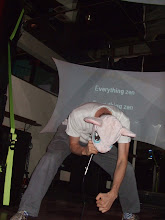Instead of an alarm clock that wakes you up at a particular time, this alarm clock would wake you up at a particular stage in your sleep cycle —— whatever stage that is that's easiest to wake up at (which, after some research, turns out is the dream stage, REM.)
But, lo and behold, more proof that this blog should be titled "My great inventions that someone has already invented":
Someone already came up with a similar product, called Zeo (sounds like a character in Power Rangers
 , huh?) Their website looks right-on. Zeo is exactly what I had already invented in my brain: It's a headband that you wear during the night which monitors your sleep patterns. It wakes you up after a certain number of cycles. Not only does Zeo wake you up at the "right" time, but it also monitors your night's sleep, so you can see what your brainwaves were doing all night.
, huh?) Their website looks right-on. Zeo is exactly what I had already invented in my brain: It's a headband that you wear during the night which monitors your sleep patterns. It wakes you up after a certain number of cycles. Not only does Zeo wake you up at the "right" time, but it also monitors your night's sleep, so you can see what your brainwaves were doing all night.Apparently, Zeo isn't for sale yet, but they are choosing a select group of people to be their beta-testers. My middle name is Guinea Pig
 , so I signed up for their waiting list.
, so I signed up for their waiting list.I did some more googling, and there's a similar product already out there, Sleeptracker.
Just based on their website, I don't trust Sleeptracker as much as the guys who make Zeo. Too info-mercial, too daytime-television.
Anyone have experience with this type of stuff? Once I did a professional sleep study at a hospital. The intent was to analyze my brainwaves throughout the night to see when and how long I was going into the various cycles of sleep: beta, delta, REM. It was way more complicated than wearing a headband, let alone a wristwatch. They covered my scalp with so many clips and suction cups that it was uncomfortable.
I'm doubtful that a headband could be as accurate as all those sensors of the professional lab. But maybe it's not important to be all that accurate when a crude reading will suffice for the given purposes.
Further testing will be required. Who wants to get me a Sleeptracker for my birthday?




